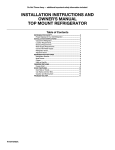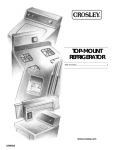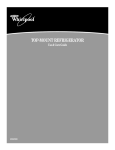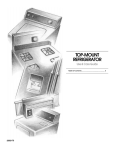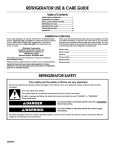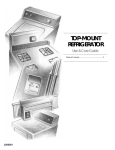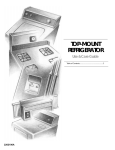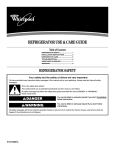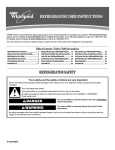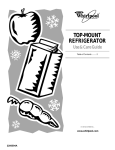Download Estate Refrigerator Use & care guide
Transcript
REFRIGERATOR USE & CARE GUIDE Table of Contents ASSISTANCE OR SERVICE ............................ 1 REFRIGERATOR SAFETY............................... 1 INSTALLATION INSTRUCTIONS ................... 2 REFRIGERATOR USE ..................................... 7 REFRIGERATOR CARE................................... 9 TROUBLESHOOTING.................................... 10 WARRANTY.................................................... 12 Assistance or Service If you need assistance or service, first see the “Troubleshooting” section. Additional help is available by calling the Estate Customer eXperience Center at 1-800-253-1301 from anywhere in the U.S.A., or write: Estate Brand Home Appliances Customer eXperience Center 553 Benson Road Benton Harbor, MI 49022-2692 Please include a daytime phone number in your correspondence. Keep this book and your sales slip together for future reference. You must provide proof of purchase or installation date for in-warranty service. Write down the following information about your appliance to help you obtain assistance or service if you ever need it. You will need to know your complete model number and serial number. You can find this information on the model and serial number label, located on the inside wall of the refrigerator compartment. Dealer name____________________________________________________ Serial number __________________________________________________ Address ________________________________________________________ Phone number __________________________________________________ Model number __________________________________________________ Purchase date __________________________________________________ REFRIGERATOR SAFETY Your safety and the safety of others are very important. We have provided many important safety messages in this manual and on your appliance. Always read and obey all safety messages. This is the safety alert symbol. This symbol alerts you to potential hazards that can kill or hurt you and others. All safety messages will follow the safety alert symbol and either the word “DANGER” or “WARNING.” These words mean: DANGER WARNING You can be killed or seriously injured if you don't immediately follow instructions. You can be killed or seriously injured if you don't follow instructions. All safety messages will tell you what the potential hazard is, tell you how to reduce the chance of injury, and tell you what can happen if the instructions are not followed. 2314465 IMPORTANT SAFETY INSTRUCTIONS WARNING: To reduce the risk of fire, electric shock, or injury when using your refrigerator, follow these basic precautions: ■ Plug into a grounded 3 prong outlet. ■ Use nonflammable cleaner. ■ Do not remove ground prong. ■ ■ Do not use an adapter. ■ Do not use an extension cord. ■ Keep flammable materials and vapors, such as gasoline, away from refrigerator. Use two or more people to move and install refrigerator. ■ Disconnect power before servicing. ■ ■ Replace all parts and panels before operating. ■ Remove doors from your old refrigerator. ■ Disconnect power before installing ice maker (on ice maker kit ready models only). Use a sturdy glass when dispensing ice or water (on some models). SAVE THESE INSTRUCTIONS Proper Disposal of Your Old Refrigerator WARNING Before You Throw Away Your Old Refrigerator or Freezer: ■ Take off the doors. ■ Leave the shelves in place so that children may not easily climb inside. Suffocation Hazard Remove doors from your old refrigerator. Failure to do so can result in death or brain damage. IMPORTANT: Child entrapment and suffocation are not problems of the past. Junked or abandoned refrigerators are still dangerous – even if they will sit for “just a few days.” If you are getting rid of your old refrigerator, please follow these instructions to help prevent accidents. INSTALLATION INSTRUCTIONS Unpack the Refrigerator WARNING IMPORTANT: Do not remove the white foam air return insert from behind the control panel on the ceiling of the refrigerator. If the insert is removed, ice may migrate down from the freezer and cause icicles to form. When Moving Your Refrigerator: Excessive Weight Hazard Use two or more people to move and install refrigerator. Failure to do so can result in back or other injury. Remove the Packaging Do not use sharp instruments, rubbing alcohol, flammable fluids, or abrasive cleaners to remove tape or glue. These products can damage the surface of your refrigerator. For more information, see “Refrigerator Safety.” 2 Your refrigerator is heavy. When moving the refrigerator for cleaning or service, be sure to protect the floor. Always pull the refrigerator straight out when moving it. Do not wiggle or “walk” the refrigerator when trying to move it, as floor damage could occur. Clean Before Using Electrical Requirements After you remove all of the package materials, clean the inside of your refrigerator before using it. See the cleaning instructions in “Refrigerator Care.” WARNING Important information to know about glass shelves and covers: Do not clean glass shelves or covers with warm water when they are cold. Shelves and covers may break if exposed to sudden temperature changes or impact, such as bumping. For your protection, tempered glass is designed to shatter into many small, pebble-size pieces. This is normal. Glass shelves and covers are heavy. Use special care when removing them to avoid impact from dropping. Electrical Shock Hazard Plug into a grounded 3 prong outlet. Do not remove ground prong. Do not use an adapter. Do not use an extension cord. Location Requirements Failure to follow these instructions can result in death, fire, or electrical shock. WARNING Before you move your refrigerator into its final location, it is important to make sure you have the proper electrical connection. Recommended Grounding Method Explosion Hazard Keep flammable materials and vapors, such as gasoline, away from refrigerator. Failure to do so can result in death, explosion, or fire. To ensure proper ventilation for your refrigerator, allow for a ½" (1.25 cm) space on each side and at the top. When installing your refrigerator next to a fixed wall, leave 2" (5.08 cm) minimum clearance on each side (some models require more) to allow for the door to swing open. If your refrigerator has an ice maker, allow extra space at the back for the water line connections. NOTE: It is recommended that you do not install the refrigerator near an oven, radiator, or other heat source. Do not install the refrigerator in a location where the temperature will fall below 55°F (13°C). A 115 Volt, 60 Hz., AC only 15- or 20-amp fused, grounded electrical supply is required. It is recommended that a separate circuit serving only your refrigerator be provided. Use an outlet that cannot be turned off by a switch. Do not use an extension cord. NOTE: Before performing any type of installation, cleaning, or removing a light bulb, turn the control (Thermostat, Refrigerator or Freezer Control depending on the model) to OFF and then disconnect the refrigerator from the electrical source. When you are finished, reconnect the refrigerator to the electrical source and reset the control (Thermostat, Refrigerator or Freezer Control depending on the model) to the desired setting. Water Supply Requirements Read all directions before you begin. IMPORTANT: ■ If you turn the refrigerator on before the water line is connected, turn the ice maker OFF. ■ All installations must meet local plumbing code requirements. ■ Use copper tubing and check for leaks. Install copper tubing only in areas where the household temperatures will remain above freezing. TOOLS NEEDED: Flat-blade screwdriver, ⁷⁄₁₆" and ¹⁄₂" open-end wrenches or two adjustable wrenches, ¹⁄₄" nut driver and drill bit, hand drill or electric drill (properly grounded). NOTE: Your refrigerator dealer has a kit available with a ¹⁄₄" (6.35 mm) saddle-type shutoff valve, a union, and copper tubing. Before purchasing, make sure a saddle-type valve complies with your local plumbing codes. Do not use a piercing-type or ³⁄₁₆" (4.76 mm) saddle valve which reduces water flow and clogs more easily. 1/2 " (1.25 cm) Water Pressure 2" (5.08 cm) A cold water supply with water pressure of between 30 and 120 psi (207 - 827 kPa) is required to operate the water dispenser and ice maker. If you have questions about your water pressure, call a licensed, qualified plumber. Reverse Osmosis Water Supply IMPORTANT: The pressure of the water supply coming out of a reverse osmosis system going to the water inlet valve of the refrigerator needs to be between 30 and 120 psi (207 - 827 kPa). 3 If a reverse osmosis water filtration system is connected to your cold water supply, the water pressure to the reverse osmosis system needs to be a minimum of 40 to 60 psi (276 - 414 kPa). If the water pressure to the reverse osmosis system is less than 40 to 60 psi (276 - 414 kPa): ■ Check to see whether the sediment filter in the reverse osmosis system is blocked. Replace the filter if necessary. ■ Allow the storage tank on the reverse osmosis system to refill after heavy usage. If you have questions about your water pressure, call a licensed, qualified plumber. Connect the Water Supply Connect to Refrigerator 1. Unplug refrigerator or disconnect power. 2. Attach the copper tube to the valve inlet using a compression nut and sleeve as shown. Tighten the compression nut. Do not overtighten. 3. Use the tube clamp on the back of the refrigerator to secure the tubing to the refrigerator as shown. This will help prevent damage to the tubing when the refrigerator is pushed back against the wall. 4. Turn shutoff valve ON. 5. Check for leaks. Tighten any connections (including connections at the valve) or nuts that leak. Read all directions before you begin. IMPORTANT: If you turn the refrigerator on before the water line is connected, turn the ice maker OFF. A B Connect to Water Line 1. Unplug refrigerator or disconnect power. 2. Turn OFF main water supply. Turn ON nearest faucet long enough to clear line of water. 3. Locate a ½" to 1¹⁄₄" (1.25 cm to 3.18 cm) vertical cold water pipe near the refrigerator. IMPORTANT: ■ Make sure it is a cold water pipe. ■ Horizontal pipe will work, but drill on the top side of the pipe, not the bottom. This will help keep water away from the drill and normal sediment from collecting in the valve. C D A. Tube clamp B. Copper tubing C. Compression nut D. Valve inlet 6. The ice maker is equipped with a built-in water strainer. If your water conditions require a second water strainer, install it in the ¹⁄₄" (6.35 mm) water line at either tube connection. Obtain a water strainer from your nearest appliance dealer. Complete the Installation 4. Determine the length of copper tubing you need. Measure from the connection on the lower left rear of refrigerator to the water pipe. Add 7 ft (2.1 m) to allow for cleaning. Use ¹⁄₄" (6.35 mm) O.D. (outside diameter) copper tubing. Be sure both ends of copper tubing are cut square. 5. Using a grounded drill, drill a ¹⁄₄" hole in the cold water pipe you have selected. WARNING A B G C Electrical Shock Hazard Plug into a grounded 3 prong outlet. F A. Cold water pipe B. Pipe clamp C. Copper tubing D. Compression nut E D Do not remove ground prong. E. Compression sleeve F. Shutoff valve G. Packing nut 6. Fasten the shutoff valve to the cold water pipe with the pipe clamp. Be sure the outlet end is solidly in the ¹⁄₄" drilled hole in the water pipe and that the washer is under the pipe clamp. Tighten the packing nut. Tighten the pipe clamp screws slowly and evenly so washer makes a watertight seal. Do not overtighten or you may crush the copper tubing. 7. Slip the compression sleeve and compression nut on the copper tubing as shown. Insert the end of the tubing into the outlet end squarely as far as it will go. Screw compression nut onto outlet end with adjustable wrench. Do not overtighten. 8. Place the free end of the tubing in a container or sink, and turn ON the main water supply. Flush the tubing until water is clear. Turn OFF the shutoff valve on the water pipe. Coil the copper tubing. 4 Do not use an adapter. Do not use an extension cord. Failure to follow these instructions can result in death, fire, or electrical shock. Plug in refrigerator or reconnect power. NOTE: Allow 24 hours to produce the first batch of ice. Discard the first three batches of ice produced. Allow 3 days to completely fill ice container. Refrigerator Doors TOOLS NEEDED: ⁵⁄₁₆" hex-head socket wrench, #2 Phillips screwdriver, flat-blade screwdriver, ⁵⁄₁₆" open-end wrench, flat 2" putty knife. IMPORTANT: ■ Unplug refrigerator or disconnect power. ■ Remove food and adjustable door or utility bins from doors. ■ If you only want to remove and replace the doors, see “Remove Doors and Hinges” and “Replace Doors and Hinges.” Remove Doors and Hinges ⁵⁄₁₆'' Hex-Head Hinge Screw 1. Unplug refrigerator or disconnect power. 2. Open refrigerator door and remove base grille from the bottom front of the refrigerator. See Base Grille graphic. 3. Close the refrigerator door and keep both doors closed until you are ready to lift them free from the cabinet. NOTE: Provide additional support for the doors while the hinges are being moved. Do not depend on the door magnets to hold the doors in place while you are working. 4. Remove the parts for the top hinge as shown in Top Hinge graphic. Lift the freezer door free from the cabinet. 5. Remove the parts for the center hinge as shown in the Center Hinge graphic. Lift the refrigerator door free from the cabinet. 6. Remove the parts for the bottom hinge as shown in the Bottom Hinge graphic. Reverse Doors (optional) IMPORTANT: If you want to reverse your doors so that they open in the opposite direction, follow these steps. If you are not reversing the doors, see “Replace Doors and Hinges.” Door Stop Screw Door Hinge Hole Plug Door Handle Sealing Screw Cabinet Hinge Hole Plug 3. Remove the door hinge hole plug from refrigerator door. Move it to the opposite side hinge hole as shown in Graphic 3. 4. Remove the door handle sealing screws. Move them to the opposite side of the refrigerator door as shown in Graphic 4. 5. Remove the door handle seal screw front. Move it to the opposite side of the refrigerator door as shown in Graphic 7. 6. Remove the door stop. Move it to the opposite side of the refrigerator door as shown in Graphic 5. 7. Position the refrigerator handle on opposite side of the refrigerator door as shown in Graphic 6-3. Drive the two top screws in the handle first. Align the lower portion of the handle and drive the bottom screw. 8. Align refrigerator bottom trim. For Style 1, replace the door handle screw cover. See Graphic 6-1. For Style 2, slide trim into place. See Graphic 6-2. 9. Tighten all screws. Set aside refrigerator door until bottom hinge is installed on product. Replace Doors and Hinges NOTE: Graphic may be reversed if door swing is reversed. 1. Replace the parts for the bottom hinge as shown and tighten screws. See Bottom Hinge graphic. Replace the refrigerator door. NOTE: Provide additional support for the doors while the hinges are being moved. Do not depend on the door magnets to hold the doors in place while you are working. 2. Assemble the parts for the center hinge as shown and tighten all screws. See Center Hinge graphic. Replace the freezer door. 3. Assemble the parts of the top hinge as shown in the Top Hinge graphic. Do not tighten the screws completely. 4. Line up the doors so that the bottom of the freezer door aligns evenly with the top of the refrigerator door. Tighten all screws. Final Steps Flat-Head Handle Screw Door Handle Screw Cover Door Handle Seal Screw Front Round-Head Handle Screw Cabinet 1. Remove ⁵⁄₁₆" hex-head hinge screws from the handle side and move them to the opposite side. See Graphic 1-1. 2. Remove the cabinet hinge hole plugs from the cabinet top and move them to the opposite side hinge holes as shown in Graphic 1-2. Freezer door 1. Remove freezer handle assembly as shown. Keep all parts together. See Graphic 2. 2. Remove the door hinge hole plug. Move it to the opposite side as shown in Graphic 3. 3. Remove the door handle sealing screws. Move them to the opposite side of the freezer door as shown in Graphic 4. 4. Remove the door stop. Move it to the opposite side of the freezer door as shown in Graphic 5. 5. Position the freezer handle on opposite side of freezer door. Assemble handles on the door as shown in Graphic 2. 6. Tighten all screws. Set aside the door until the hinges and refrigerator compartment door are in place. Refrigerator door 1. Remove refrigerator handle bottom trim. For Style 1, remove the handle screw cover. See Graphic 6-1. For Style 2, slide trim down as shown in Graphic 6-2. 2. Remove the refrigerator handle assembly as shown. Keep all parts together. See Graphic 6-3. 1. Check all the holes to make sure that hole plugs and screws are in place. Reinstall the top hinge cover as shown in the Top Hinge graphic. 2. Replace the base grille. See Base Grille graphic. WARNING Electrical Shock Hazard Plug into a grounded 3 prong outlet. Do not remove ground prong. Do not use an adapter. Do not use an extension cord. Failure to follow these instructions can result in death, fire, or electrical shock. 3. Plug in refrigerator or reconnect power. 4. Return all removable door parts to doors and food to refrigerator. 5 Door Removal & Replacement Standard Door - Door Swing Reversal (optional) 1-2 2 Base Grille A A A. Cabinet Hinge Hole Plugs B 3 1-1 A A A A. Door Hinge Hole Plug 1 Top Hinge A. ⁵⁄₁₆" Hex-Head Hinge Screws B C A A. Top Hinge Cover B. ⁵⁄₁₆" Hex-Head Hinge Screws C. Top Hinge A. Flat-Head Handle Screws B. Freezer Handle Center Hinge 4 A A 7 B A. Door Handle Sealing Screws Side View Front View 5 A. Center Hinge B. ⁵⁄₁₆" Hex-Head Hinge Screws Bottom Hinge A. Door Stop Screw B. Door Stop A A. Door Handle Seal Screw Front B A 6-1 B A. Bottom Hinge B. ⁵⁄₁₆" Hex-Head Hinge Screws 6-2 A 6-3 B A C A. Door Handle Screw Cover 6 A. Flat-Head Handle Screw B. Refrigerator Handle C. Handle Screw Adjust the Doors Door Closing Your refrigerator has two front adjustable rollers – one on the right and one on the left. If your refrigerator seems unsteady or you want the doors to close easier, adjust the refrigerator's tilt using the instructions below. WARNING 5. Open both doors again and check to make sure that they close as easily as you like. If not, tilt the refrigerator slightly more to the rear by turning both leveling screws to the right. It may take several more turns, and you should turn both leveling screws the same amount. 6. Replace the base grille. Align Doors If the space between your doors looks uneven, you can adjust it using the instructions below: 1. Pry off the top hinge cover. 2. Loosen the top hinge screws using a ⁵⁄₁₆" socket or wrench. 3. Have someone hold the door in place or put a spacer between the doors while you tighten the top hinge screws. 4. Replace the top hinge cover. REFRIGERATOR USE Electrical Shock Hazard Plug into a grounded 3 prong outlet. Using the Controls Do not remove ground prong. Do not use an adapter. Do not use an extension cord. Failure to follow these instructions can result in death, fire, or electrical shock. For your convenience, your refrigerator controls are preset at the factory. When you first install your refrigerator, make sure that the controls are still preset to the mid-settings as shown. NOTE: To turn your refrigerator off, turn the refrigerator control to the word OFF or until the word OFF appears. Your product will not cool when the refrigerator control is set to OFF. Mid-setting “3” 1. Plug into a grounded 3 prong outlet. WARNING Excessive Weight Hazard Use two or more people to move and install refrigerator. Mid-setting “3” Failure to do so can result in back or other injury. 2. Move the refrigerator into its final location. 3. Remove the base grille. See Base Grille graphic. The two leveling screws are part of the front roller assemblies which are at the base of the refrigerator on either side. 4. Use a screwdriver to adjust the leveling screws. Turn the leveling screw to the right to raise that side of the refrigerator or turn the leveling screw to the left to lower that side. It may take several turns of the leveling screws to adjust the tilt of the refrigerator. NOTE: Having someone push against the top of the refrigerator takes some weight off the leveling screws and rollers. This makes it easier to adjust the screws. Mid-setting “4” REFRIGERATOR 4 4 FREEZER IMPORTANT: ■ Give your refrigerator time to cool down completely before adding food. It is best to wait 24 hours before you put food into the refrigerator. ■ If you add food before the refrigerator has cooled completely, your food may spoil. Adjusting the Refrigerator and Freezer Controls to a higher (colder) than recommended setting will not cool the compartments any faster. 7 Adjusting Controls Ice Maker The mid-settings indicated in the previous section should be correct for normal household usage. The controls are set correctly when milk or juice is as cold as you like and when ice cream is firm. If the temperature is too warm or too cold in the refrigerator or freezer, first check the air vents to be sure they are not blocked. If you need to adjust temperatures, use the settings listed in the chart below as a guide. On models with two controls, adjust the refrigerator temperature first. Wait at least 24 hours between adjustments and then recheck the temperatures. CONDITION/REASON: ADJUSTMENT: REFRIGERATOR too warm REFRIGERATOR or TEMPERATURE Control one setting higher FREEZER too warm/too little ice FREEZER or TEMPERATURE Control one setting higher MAX ice production switch REFRIGERATOR too cold REFRIGERATOR or TEMPERATURE Control one setting lower FREEZER too cold FREEZER or TEMPERATURE Control one setting lower Crisper Humidity Control (on some models) You can control the amount of humidity in the moisture-sealed crisper. Adjust the control to any setting between LOW and HIGH. LOW (open) for best storage of fruits and vegetables with skins. HIGH (closed) for best storage of fresh, leafy vegetables. Turning the Ice Maker On/Off To turn the ice maker ON, simply lower the wire shutoff arm. To manually turn the ice maker OFF, lift the wire shutoff arm to the OFF (arm up) position and listen for the click. NOTE: Your ice maker has an automatic shutoff. As ice is made, the ice cubes will fill the ice storage bin and the ice cubes will raise the wire shutoff arm to the OFF (arm up) position. Do not force the wire shutoff arm up or down. Ice Production Rate ■ Allow 24 hours to produce the first batch of ice. Discard the first three batches of ice produced. ■ The ice maker should produce approximately 8 to 12 batches of ice in a 24-hour period. ■ To increase ice production, lower the freezer and refrigerator temperature. See “Using the Controls.” Wait 24 hours between adjustments. ■ For maximum ice production (on some models), push the switch to ICE PLUS. The ice maker should produce 16 to 20 batches of ice in a 24-hour period in the Ice Plus mode. Remember 8 ■ The quality of your ice will be only as good as the quality of the water supplied to your ice maker. Avoid connecting the ice maker to a softened water supply. Water softener chemicals (such as salt) can damage parts of the ice maker and lead to poor quality ice. If a softened water supply cannot be avoided, make sure the water softener is operating properly and is well maintained. ■ Never use anything sharp to break up the ice in the bin. This can cause damage to the ice container and the dispenser mechanism. ■ Do not store anything on top of or in the ice maker or ice bin. REFRIGERATOR CARE Cleaning WARNING Explosion Hazard 4. There is no need for routine condenser cleaning in normal home operating environments. If the environment is particularly greasy or dusty, or there is significant pet traffic in the home, the condenser should be cleaned every 2 to 3 months to ensure maximum efficiency. If you need to clean the condenser: ■ Remove the base grille. ■ Use a vacuum cleaner with a soft brush to clean the grille, the open areas behind the grille and the front surface area of the condenser. ■ Replace the base grille when finished. 5. Plug in refrigerator or reconnect power. Use nonflammable cleaner. Failure to do so can result in death, explosion, or fire. Changing the Light Bulbs Both the refrigerator and freezer sections defrost automatically. However, clean both sections about once a month to prevent odors from building up. Wipe up spills immediately. IMPORTANT: Because air circulates between both sections, any odors formed in one section will transfer to the other. You must thoroughly clean both sections to eliminate odors. To prevent odor transfer and drying out of food, wrap or cover foods tightly. NOTE: Not all bulbs will fit your refrigerator. Be sure to replace the bulb with one of the same size, shape, and wattage. 1. Unplug refrigerator or disconnect power. 2. Remove the bulb from behind the control panel in the refrigerator or from behind the light shield in the freezer (on some models). Replace it with a bulb of the same wattage. 3. Plug in refrigerator or reconnect power. To Clean Your Refrigerator: NOTE: Do not use abrasive or harsh cleaners such as window sprays, scouring cleansers, flammable fluids, cleaning waxes, concentrated detergents, bleaches or cleansers containing petroleum products on plastic parts, interior and door liners or gaskets. Do not use paper towels, scouring pads, or other harsh cleaning tools. 1. Unplug refrigerator or disconnect power. 2. Hand wash, rinse, and dry removable parts and interior surfaces thoroughly. Use a clean sponge or soft cloth and a mild detergent in warm water. 3. Wash stainless steel and painted metal exteriors with a clean sponge or soft cloth and a mild detergent in warm water. 1 WARMER 2 WARMER 1 2 FREEZER 3 SETTING RECOMMENDED REFRIGERATOR 4 3 RECOMMENDED SETTING COOLER 5 4 ADJUSTMENTS ALLOW 24 HOURS BETWEEN 5 COOLER 9 TROUBLESHOOTING Try the solutions suggested here first in order to avoid the cost of an unnecessary service call. Refrigerator Operation ■ Hissing/Rattling - flow of refrigerant, movement of water lines, or from items placed on top of the refrigerator. ■ Sizzling/Gurgling - water dripping on the heater during defrost cycle. The refrigerator will not operate ■ Power cord unplugged? Plug into a grounded 3 prong outlet. ■ Is outlet working? Plug in a lamp to see if the outlet is working. ■ Popping - contraction/expansion of inside walls, especially during initial cool-down. ■ Household fuse blown or circuit breaker tripped? Replace the fuse or reset the circuit breaker. ■ Water running - may be heard when water melts during the defrost cycle and runs into the drain pan. ■ Are controls on? Make sure the refrigerator controls are on. See “Using the Controls.” ■ Creaking/Cracking - occurs as ice is being ejected from the ice maker mold. ■ New installation? Allow 24 hours following installation for the refrigerator to cool completely. NOTE: Adjusting the temperature controls to coldest setting will not cool either compartment more quickly. The doors will not close completely ■ Door blocked open? Move food packages away from door. ■ Bin or shelf in the way? Push bin or shelf back in the correct position. The motor seems to run too much Your new refrigerator may run longer than your old one due to its high-efficiency compressor and fans. The unit may run even longer if the room is warm, a large food load is added, doors are opened often, or if the doors have been left open. The refrigerator seems noisy Refrigerator noise has been reduced over the years. Due to this reduction, you may hear intermittent noises from your new refrigerator that you did not notice from your old model. Below are listed some normal sounds with explanations. ■ Buzzing - heard when the water valve opens to fill the ice maker. ■ 10 Pulsating - fans/compressor adjusting to optimize performance. The doors are difficult to open ■ Gaskets dirty or sticky? Clean gaskets and contact surfaces with mild soap and warm water. Rinse and dry with soft cloth. ■ Large amount of ice recently removed? Allow 24 hours for ice maker to produce more ice. ■ Ice cube jammed in the ice maker ejector arm? Remove ice from the ejector arm with a plastic utensil. ■ Reverse osmosis water filtration system connected to your cold water supply? This can decrease water pressure. See “Water Supply Requirements.” Temperature and Moisture Temperature is too warm ■ New installation? Allow 24 hours following installation for the refrigerator to cool completely. ■ Door(s) opened often or left open? Allows warm air to enter refrigerator. Minimize door openings and keep doors fully closed. ■ Large load of food added? Allow several hours for refrigerator to return to normal temperature. ■ Controls set correctly for the surrounding conditions? Adjust the controls a setting colder. Check temperature in 24 hours. See “Using the Controls.” The ice cubes are hollow or small NOTE: This is an indication of low water pressure. ■ Water shutoff valve not fully open? Turn the water shutoff valve fully open. ■ Kink in the water source line? A kink in the line can reduce water flow. Straighten the water source line. ■ Reverse osmosis water filtration system connected to your cold water supply? This can decrease water pressure. See “Water Supply Requirements.” ■ Questions remain regarding water pressure? Call a licensed, qualified plumber. There is interior moisture buildup NOTE: Some moisture build-up is normal. ■ Humid room? Contributes to moisture build-up. ■ Door(s) opened often or left open? Allows humid air to enter refrigerator. Minimize door openings and keep doors fully closed. Ice and Water The ice maker is not producing ice or not enough ice ■ Refrigerator connected to a water supply and the supply shutoff valve turned on? Connect refrigerator to water supply and turn water shutoff valve fully open. ■ Kink in the water source line? A kink in the line can reduce water flow. Straighten the water source line. ■ Ice maker turned on? Make sure wire shutoff arm or switch (depending on model) is in the ON position. ■ New installation? Wait 24 hours after ice maker installation for ice production to begin. Wait 72 hours for full ice production. Off-taste, odor or gray color in the ice ■ New plumbing connections? New plumbing connections can cause discolored or off-flavored ice. ■ Ice stored too long? Discard ice. Wash ice bin. Allow 24 hours for ice maker to make new ice. ■ Odor transfer from food? Use airtight, moisture proof packaging to store food. ■ Are there minerals (such as sulfur) in the water? A water filter may need to be installed to remove the minerals. 11 WHIRLPOOL CORPORATION MAJOR APPLIANCE WARRANTY ONE YEAR LIMITED WARRANTY For one year from the date of purchase, when this major appliance is operated and maintained according to instructions attached to or furnished with the product, Whirlpool Corporation or Whirlpool Canada LP (hereafter “Whirlpool”) will pay for FSP® replacement parts and repair labor to correct defects in materials or workmanship. Service must be provided by a Whirlpool designated service company. ITEMS WHIRLPOOL WILL NOT PAY FOR 1. Service calls to correct the installation of your major appliance, to instruct you how to use your major appliance, to replace or repair house fuses or to correct house wiring or plumbing. 2. Service calls to repair or replace appliance light bulbs, air filters or water filters. Those consumable parts are excluded from warranty coverage. 3. Repairs when your major appliance is used for other than normal, single-family household use. 4. Damage resulting from accident, alteration, misuse, abuse, fire, flood, acts of God, improper installation, installation not in accordance with electrical or plumbing codes, or use of products not approved by Whirlpool. 5. Any food loss due to refrigerator or freezer product failures. 6. Replacement parts or repair labor costs for units operated outside the United States or Canada. 7. Pickup and delivery. This major appliance is designed to be repaired in the home. 8. Repairs to parts or systems resulting from unauthorized modifications made to the appliance. 9. Expenses for travel and transportation for product service in remote locations. 10. The removal and reinstallation of your appliance if it is installed in an inaccessible location or is not installed in accordance with published installation instructions. DISCLAIMER OF IMPLIED WARRANTIES; LIMITATION OF REMEDIES CUSTOMER'S SOLE AND EXCLUSIVE REMEDY UNDER THIS LIMITED WARRANTY SHALL BE PRODUCT REPAIR AS PROVIDED HEREIN. IMPLIED WARRANTIES, INCLUDING WARRANTIES OF MERCHANTABILITY OR FITNESS FOR A PARTICULAR PURPOSE, ARE LIMITED TO ONE YEAR OR THE SHORTEST PERIOD ALLOWED BY LAW. WHIRLPOOL SHALL NOT BE LIABLE FOR INCIDENTAL OR CONSEQUENTIAL DAMAGES. SOME STATES AND PROVINCES DO NOT ALLOW THE EXCLUSION OR LIMITATION OF INCIDENTAL OR CONSEQUENTIAL DAMAGES, OR LIMITATIONS ON THE DURATION OF IMPLIED WARRANTIES OF MERCHANTABILITY OR FITNESS, SO THESE EXCLUSIONS OR LIMITATIONS MAY NOT APPLY TO YOU. THIS WARRANTY GIVES YOU SPECIFIC LEGAL RIGHTS AND YOU MAY ALSO HAVE OTHER RIGHTS, WHICH VARY FROM STATE TO STATE OR PROVINCE TO PROVINCE. Outside the 50 United States and Canada, this warranty does not apply. Contact your authorized Whirlpool dealer to determine if another warranty applies. If you need service, first see the “Troubleshooting” section of the Use & Care Guide. After checking “Troubleshooting,” additional help can be found by checking the “Assistance or Service” section or by calling Whirlpool. In the U.S.A., call 1-800-253-1301. In Canada, call 1-800-807-6777. 8/05 2314465 © 2005 Whirlpool Corporation. All rights reserved. ® Registered Trademark/TM Trademark of Whirlpool, U.S.A. 9/05 Printed in U.S.A.












